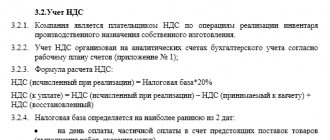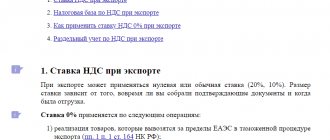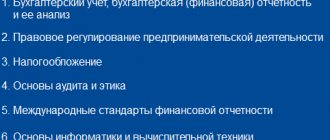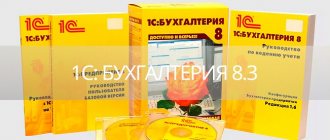If an organization simultaneously carries out transactions that are taxed and not subject to VAT, it is obliged to carry out separate accounting for tax amounts. This is provided for in Art. 170 Tax Code of the Russian Federation. Collection amounts for taxable transactions are accepted for deduction. In another situation, you have to draw up proportions for each tax period according to the amounts of goods shipped. The “5 percent” VAT rule has been developed specifically for these purposes. An example of calculating the amount of tax in different situations will be discussed in detail below.
The essence
Trade organizations often have to combine a general taxation regime with a single tax. The presence of export operations is also the basis for separate accounting. The reason is that when exporting, VAT is deducted on the last day of the month when documents were provided confirming the use of a zero rate for such an operation. The procedure for calculating tax on these transactions is determined by the accounting policy.
Let us consider in more detail how such organizations carry out separate VAT accounting.
To reflect the distribution of the tax amount in the accounting system, subaccounts to account 19 are used. The distribution is carried out in the period in which the goods were registered. Therefore, the proportion is carried out according to comparable indicators - the cost of the goods with and without VAT. Double accounting is also carried out if the organization has operations that are carried out outside the Russian Federation.
Separate accounting for export
Here you cannot do without separate accounting. The raw materials used in the process of export operations, that is, their amount, are presented to the tax authorities in a separately drawn up declaration with a zero rate. There is no legally established methodology for determining input VAT on exported goods. It is chosen independently and is necessarily enshrined in orders relating to accounting policies.
If the company did not know whether it would export products and accepted standard input VAT on a general basis, then the tax paid can be restored. To do this, you will need to submit an updated declaration form and pay the tax amount.
Example 1
Let's consider a standard situation. During the quarter, the company shipped products worth 1.2 million rubles, including taxable products worth 0.9 million rubles. The amount of tax presented by suppliers is 100 thousand rubles. Since the cost of the goods, which is not subject to taxation, is 250 thousand rubles, the calculated coefficient is 0.75. Therefore, you can deduct not 100 thousand rubles, but only 75 thousand rubles. (100 * 0.75). And only 25% can be taken into account in the cost of purchased goods: 1.2 * 0.25 = 0.3 million rubles.
Calculations
How to distribute input VAT? An enterprise may have fixed assets and intangible assets registered in the first month of the quarter. In such cases, the proportions are determined based on the share of the cost of shipped goods manufactured on a new machine in the total sales amount for the month in which the object was accepted for accounting.
The cost of services for providing loans and repo transactions is calculated based on the amount of income in the form of accrued interest. The exception is an interest-free loan, the cost of which is equal to zero. Such operations do not affect the proportion
When calculating the Central Bank, the difference between the sale price and acquisition costs is calculated. At the same time, non-VAT-taxable transactions must also be taken into account in the cost of work.
5% rule
For those periods when the share of expenses on non-taxable transactions is less than 5% of the total amount of expenses, the company may not carry out separate accounting. The procedure for calculating the total amount of expenses when calculating the barrier is not established by law. An enterprise can develop its own justified methodology and consolidate it in its accounting policies.
When calculating the share, all sales excluding VAT are taken into account: non-taxable transactions, sales on imputation, expenses for transactions outside the Russian Federation. As for the first group, both direct and general expenses are taken into account. That is, you need to add up all the costs, add VAT on general business expenses in the appropriate proportion, then divide the resulting amount by the amount of costs.
The “5 percent” rule for VAT, an example of the calculation of which will be presented below, cannot be applied to export transactions. This is provided for in Art. 170 NK. For such transactions the VAT rate is 0%. That is, if:
- the barrier has not been reached;
- the enterprise has export operations;
It is necessary to carry out separate VAT accounting.
Features of maintaining separate accounting
Almost often, commercial enterprises work with products subject to and exempt from VAT. Determining the amounts for these transactions will not be so easy.
Separate VAT accounting should be carried out strictly according to outgoing VAT, that is, the price of shipped products, taxable and exempt from tax. It is also important to take into account the input VAT, which is already included in the price of units of services or goods purchased for taxable and fully exempt transactions.
For trade transactions that are exempt from tax, as well as input VAT, are necessarily included in the cost of all goods sold, property rights and services.
There is no special methodology for maintaining separate VAT accounting. You can use any procedure that will effectively distinguish between all exempt and taxable transactions. Accounting for such transactions must be kept in different sub-accounts that are opened to standard accounting accounts. The procedure for maintaining documents, selected according to the parameters and features of the activity performed, must be enshrined in the general accounting policy of the organization.
If you do not maintain proper separate accounting, tax officials will quickly restore the entire input VAT on such units that were purchased for use in non-taxable and taxable transactions. This will automatically lead to shortfalls in VAT, and the tax office usually charges fines and penalties on them.
The 5 Percent Rule: An Example
The enterprise's direct costs for taxable operations in the second quarter amounted to 15 million rubles, and for non-taxable ones - 750 thousand rubles. General business expenses - 3.5 million rubles. The accounting policy provides for the distribution of expenses in proportion to revenue, which in the reporting period amounted to RUB 21 million, respectively. and 970 thousand rubles.
General business expenses for non-taxable transactions: 3.5 * (0.97 / (21 + 0.97))) = 154.529 thousand rubles, or 4.7%. Since this amount does not exceed 5%, the company can deduct the entire input VAT for the second quarter.
How to count
Calculate your share of expenses using the following formula:
If this rule is observed and the result obtained does not exceed 5%, then the input tax on total costs can be deducted in full without distribution.
To recap what constitutes total expenses, the five percent rule. Such costs include expenses for the acquisition of goods or their production or sale, as well as for the purchase of works, services or property rights that will be used in carrying out both non-taxable and taxable transactions.
Please note that the procedure for distributing total costs is not fixed in the Tax Code of the Russian Federation. This means that each economic entity independently determines the order of distribution of this category of costs. This decision must be fixed in your accounting policies.
Accounting algorithm
To understand what VAT rate should be applied to goods and how to determine the amount of input tax, you can use the following sequence of actions:
1. Calculate the amount of VAT claimed that can be deducted. If the purchased goods can be directly attributed to activities exempt from taxation, then VAT is included in its cost. In other cases, the tax amount is deducted.
2. At the next stage, you need to apply the “5 percent” rule for VAT, an example of the calculation of which was presented earlier. First, the amount of expenses for non-taxable transactions is determined, then the total costs are calculated and the formula is applied:
% neoreg. oper. = (Normal / Total) x 100%.
If the resulting ratio exceeds 5%, then separate accounting of the amounts should be carried out.
3. Tax amounts with and without VAT are calculated, then they are summed up and the ratio is determined:
% calc. = (Sum of region / Sum of total) * 100%.
The following determines the VAT on OSN payable:
Tax = VAT charged * % deducted.
4. The marginal cost is calculated:
VAT limit = VAT claimed - VAT deducted
or
Cost = (Amount of goods shipped, but not taxable / Total sales volume) * 100%.
Separate accounting of input VAT
Free transfer of property
The fact of gratuitous transfer of property is recognized as a sales transaction - a change of owner occurs. This is the basis for charging VAT, which is done according to general rules. Ordinary gratuitous transactions do not require separate accounting.
But there are exceptions that require separate accounting and tax calculation:
- free assistance in accordance with the provisions of Federal Law No. 95 dated May 4, 1999;
- provision of marketing products (promotional materials) at a cost of up to 100 rubles. per piece
Export operations
The need for separate accounting is determined by the nature of the exported products.
- Raw materials. Separate accounting is required.
- Non-raw materials. Tax calculation according to general rules.
For the range of raw materials, the rule of separate accounting applies to both exports and domestic transactions. Tax on such transactions is deductible on the date of the export transaction.
VAT = 0
The zero VAT rate is the basis for separate accounting. This is dictated by the combination of activities with a standard and preferential value added tax rate.
- Tax at the standard rate of 18%. It is deductible on the date of registration of assets.
- At a rate of 0%. Documents are submitted for deduction based on the results of the quarter - on its last day.
Tax deducted earlier than the above deadlines must be restored through a special procedure by sending an application to the Federal Tax Service.
Similar articles
- Features of accounting for incoming and outgoing VAT
- The procedure and features of maintaining separate VAT accounting
- How to calculate VAT at a rate of 18% of the amount?
- Incoming and outgoing VAT
- How to organize the distribution of input VAT?
Arbitrage practice
A complete interpretation of “total expenses” is not provided in the Tax Code. Based on definitions in economic dictionaries, this term can be understood as the total cost of production of goods incurred by the taxpayer himself. The Ministry of Finance explains that when calculating this value, direct and general expenses for conducting activities are taken into account.
Judicial practice also does not allow us to draw an unambiguous conclusion regarding when separate VAT accounting should be carried out. The 5 percent rule, an example of which was discussed earlier, applies exclusively to manufacturing enterprises. According to the judges, trading companies cannot carry out separate tax accounting.
Transactions with securities raise even more questions. In particular, some judges, referring to Art. 170 of the Tax Code, they claim that when selling such assets, the 5% rule can be used. At the same time, the cost of purchasing securities does not affect the proportion. That is, almost always the amount of expenses will be less than 5%, and the payer will be released from the obligation to keep double records.
In other court decisions there is a reference to PBU 19/02, which states that all transactions with the Central Bank in NU and BU relate to financial investments. In addition, organizations do not have expenses associated with the formation of the cost of such assets. That is, income from such transactions is exempt from taxation. Therefore, the organization must submit full VAT for deduction.
Transactions on the sale of a legal entity’s share in the management company of another organization are not subject to VAT. Therefore, in such cases double counting is always carried out.
Tax policy of separate accounting in the presence of tax-free transactions
It is mandatory to take into account the reasons under which such transactions are carried out that are not taxed. These could be things like:
- All preferential regimes related to taxation;
- The right to exemption from VAT on the basis of insufficient revenue;
- The presence of taxation transactions where Article 149 of the Tax Code of the Russian Federation is not provided;
- Sales of goods or services outside the country.
In cases where there have been no sales of services or goods that are not taxed for a certain period of time, many entrepreneurs wonder whether it is necessary to keep separate VAT records in this case? The Ministry of Finance takes the position that the complete absence of transactions on exempt units of goods from value added tax is the basis for exemption from separate accounting.
Example 3
Before providing funds as collateral, the company hired auditors to check the financial condition of the borrower. The cost of the company's services amounted to 118 thousand rubles. VAT included. Loan amount – 1 million rubles. The cost of financial investments is determined based on the accounting policies of the lender. If it does not provide for the use of the 5% rule, then VAT for auditor services should be taken into account in the cost of the financial investment. In this case, general business expenses will have to be distributed. If there is a reservation, then all amounts are accepted for deduction.
The issue of accounting for input VAT in transactions with debt securities remains open. Using a preferential scheme for transactions with bills of exchange is risky. The Federal Tax Service will most likely challenge such operations, and then they will have to prove their case in court.
Calculation of VAT on expenses with separate accounting
In order to distribute VAT on general business expenses (telephone communications, rental payments, office supplies, banking transactions, utilities, etc.), it is necessary to calculate:
- Amount of tax accepted for deduction:
VAT deductible = input VAT on total expenses for the reporting period × VAT deduction (in %).
This indicator must be calculated for each invoice relating to these expenses in order to register it in the purchase book only in that part that can be deducted.
- Tax related to expenses:
VAT on expenses = input VAT on total expenses for the reporting period × VAT cost (in %).
Subscribe to our newsletter
Yandex.Zen VKontakte Telegram
The above proportions are compiled when selling products (works, services). In relation to fixed assets, intangible assets, derivative financial instruments, as well as for payers carrying out clearing activities, providing loans in securities or cash, other calculation rules apply, provided for in subparagraph. 1–5 clause 4.1 art. 170 Tax Code of the Russian Federation.
Accounting
From all of the above, we can draw the following conclusion: it is better to determine the method of calculating expenses and indicate it in the accounting policy. In this case, you need to specify the entire list of costs that relate to operations exempt from taxation, and the procedure for their calculation:
- allocate a position on staff for a responsible employee;
- prescribe the procedure for recording time for making calculations;
- determine the principle for distributing the amount of rent and utilities for such operations (for example, proportionally).
To collect information about expenses not related to production, account 26 is used. It can reflect management, general business expenses, depreciation, rent, costs of information, auditing, and consulting services.
Accounting entries for separate VAT accounting
On March 31, 2020, the accountant made the following calculation:
- the amount of general business expenses attributable to technical inspection services is RUB 30,345. (325,000 × (690,000 / (6,700,000 + 690,000));
- the total amount of expenses for activities exempt from VAT is RUB 255,345. (30,345 + 225,000);
- share of expenses for tax-exempt transactions - 4.44% (255,345 / (5,200,000 + 225,000 + 325,000) × 100%).
So, JSC “LS” will reflect VAT deductible in the amount of 1,105,000 rubles. (1,040,000 + 65,000). NP expenses will include costs for activities exempt from tax - 270,000 rubles. (225,000 + 45,000).
The BU will reflect:
- Dt 68 subaccount “Calculations for VAT” Kt 19 subaccount “VAT subject to distribution between taxable and tax-exempt transactions” - 65,000 rubles;
- Dt 68 subaccount “Calculations for VAT” Kt 19 subaccount “VAT on taxable transactions” - 1,040,000 rubles;
- Dt 26 (44) subaccount “Expenses on tax-exempt transactions” Kt 19 subaccount “VAT on tax-exempt transactions” - 45,000 rubles.
In this example, the JSC, observing the 5 percent rule, accepted all VAT on general business expenses for deduction.
If expenses for non-taxable operations exceed 5%, then the tax on total expenses must be deducted in proportion to the share of revenue from taxable activities for the tax period.
VAT or UTII for individual entrepreneurs
To begin with, it is worth noting that entrepreneurs who are single tax payers do not pay VAT on transactions that are recognized as taxable. At the same time, the Tax Code states that organizations that carry out transactions subject to VAT and UTII are required to maintain double accounting of property, liabilities and transactions. For such individual entrepreneurs, the VAT accounting procedure is regulated by the Tax Code. It also spells out the work procedure of exporters located on UTII for individual entrepreneurs.
Separate accounting allows you to correctly determine the amount of tax deduction: in full or in proportion. The code states that the procedure for distributing such operations must be prescribed in the accounting policies of the organization. The above ratio is calculated based on the cost of non-taxable goods sold in total sales. Let's consider another problem that presents the “5 percent” rule for VAT.
Calculation example. An enterprise engaged in wholesale and retail trade (paying VAT and UTII) must carry out double tax accounting. Even if work, equipment, or real estate are intended for “imputed” activities, VAT on them is not deductible. If the services received or real estate purchased are intended to conduct transactions subject to VAT, then the tax charged is taken into account in full. If the purchased equipment will be used on “two fronts” at once, then a proportion must be drawn up. One part of the tax is deductible, and the second is included in the cost of goods.
Let's get to the bottom of the problem
So, if a company simultaneously carries out taxable and non-taxable transactions, then problematic situations may arise in taxation. First of all, the disputes concern VAT. For example, how to apply input tax to a deduction when combining transactions of different types? Starting this year, officials have adjusted the rules.
In such circumstances, the company is required to maintain separate accounting records. That is, take into account income and expenses separately for taxable transactions, and separately for non-taxable ones.
But it's not that simple. For example, certain types of costs can be allocated to both types of activities: taxable and non-taxable. For example, general business expenses that are incurred to ensure the life of the entity as a whole, regardless of the specific type of transaction. For expenses of this nature, separate accounting for input VAT is applied: the 5 percent rule.
What does it mean? Let's say an organization provides two types of services. The first is classified as non-taxable, and the second is subject to full VAT. Thus, an enterprise has the right to accept input VAT on general business costs in full if expenses for non-taxable transactions do not exceed 5% of total (aggregate) expenses for the corresponding quarter.
IMPORTANT!
The 5 percent VAT rule from 2021 applies only if expenses are aimed at both types of transactions: taxable and non-taxable. But if spending is aimed only at non-taxable activities, then it is no longer possible to use the 5% rule. In this case, include the amount of input tax in the cost of services, goods, and works exempt from value added tax.
Let us note that until 2021, officials took a different position. That is, previously it was possible to accept input VAT as a deduction if expenses within 5% were directed only to non-taxable transactions.
Proportion
The Tax Code specifies the specifics of accounting for ratios for transactions that are exempt from taxation. The cost of services for providing loans and repo transactions is taken into account in the amount of interest income accrued by the taxpayer. When calculating the cost of shares, bonds, and other securities, the amount of income is calculated in the form of a positive difference between the selling price and the cost of purchasing such assets. If the market price is lower than the cost, then the resulting value will not be taken into account.



